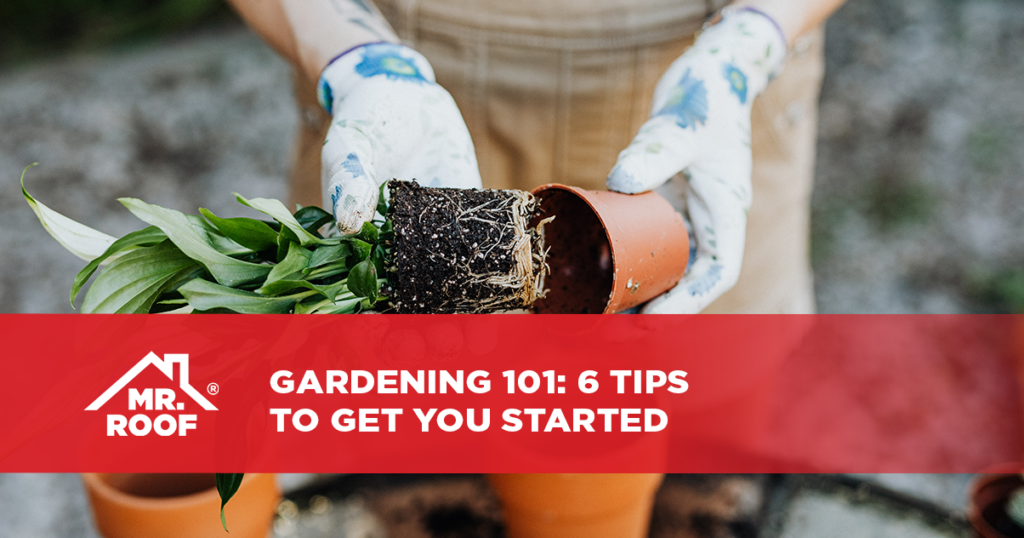Your yard should look as good as the exterior of your home. Adding plants and shrubs is an excellent way to add curb appeal to your home, and gardening will beautify your outdoor space if you do it right. Additionally, adding a vegetable garden is not only visually splendid but is also a reliable source of fresh produce. However, it can be overwhelming knowing where to start after you decide you want to add a garden to your outdoor space. Use the following six tips to help you get started.
1. Know when to plant
One of the most important things to know when planning your gardening is your area’s frost date. If flowers are planted too soon, they will fight to survive. If you are starting your flower seeds indoors before planting, make sure you give yourself enough time for the seeds to grow and root before they are ready to be planted. Start this process at least eight weeks before planting outside.
Remember, a good base will nourish your plants, and a balanced loam will benefit your flowers. Most plants have self-care instructions when purchased. Check your local listings for your frost zones. Your zone will determine when and where to plant for your location. Before you purchase your flowers, create a rough blueprint that shows where you plan to plant each flower or shrub. Give yourself room to change your plans as needed. You may decide to rearrange different plants in different areas after you get started. Experiment with the colors and texture of your flower garden. It is always a good idea to set a budget and stick to it.
2. Choose your morning sun plants
Sunlight allows plants to generate energy, and it’s crucial to choose the right plants for the morning sun. Many flowers will struggle in a hot-summer climate. If your gardening spot faces east, you should look for flowers that require cooler morning sunlight. Here are a few flowers to consider for the morning sun:
- A good plant for a beginner is the daylily. These low-maintenance plants are known to survive through unbalanced nutritional soil and drought. Daylilies are known to come in an astonishing number of colors. You can plant the daylilies together or scatter them among the rest of your landscaping.
- Shasta daisy is another low-maintenance flower to plant. They come with a variety of stem lengths and can bloom to fall. These flowers grow best in well-draining soil.
- Geraniums are hardy flowers that prefer morning sun over afternoon shade. These flowers can survive drought conditions and will bloom until the first frost.
- The Supertunia mini vista morning glory petunia is an amazingly easy and fun plant to add to your landscape. It is a flower that only needs watering once a week and is great for ground coverage. These flowers will blanket the landscape but will not impede other flowers.
- Bellflowers are anis an excellent flower for full sun and a winter hardy plant. Its upturned bell-shaped bell shape flower is a great pollinator and is known to attract bees, so it is not suggested for areas with high foot traffic.
- Violets bloom in a dark purple. Blooming in the spring, they thrive in full sun for at least half the day. Once planted, the flower will not need extra care.
3. Choose your afternoon sun plants
Other flowers do better with the afternoon sun. Consider the following plants that prefer cover from the sun in the morning and bright light later in the day:
- Marigolds are a universal plant. They can be planted for exposure in the morning or afternoon sun. Five to six hours of full sunlight is required every day for natural development.
- Bougainvillea is a vibrant plant that can tolerate drought. It can take full sun or light shade and attracts butterflies and hummingbirds.
- Impatiens will grow better in a shadier area with no more than two to four hours of direct sunlight.
- Foxglove flourishes in the afternoon sun. It thrives in cool, moist soil and can grow to be up to three feet tall.
- Dianthus loves the hot afternoon sun. This plant attracts butterflies and multiple pollinating insects.
4. Add extra curb appeal
Flowers add a gorgeous and decorative element to your landscape, but they are not the only thing you can include in your garden to elevate the look of your property. Shrubs can fill in larger gaps in your gardening plans with color. Popular shrubs include:
- Dwarf Forsythe – bright yellow, grows 1 to 2 feet tall
- Dwarf hydrangea – blooms from summer to fall
- Azalea – multiple blooming
- Boxwood – evergreen, trim to shape
If you plan to spend time outside, consider plants that repel insects, such as the following:
- Basil repels house flies and mosquitos.
- Lavender deters moths, flies, fleas, and mosquitos.
- Lemongrass repels mosquitoes.
- Rosemary repels mosquitos and various vegetable-plant insects.
- Chrysanthemums deter roaches, ants, ticks, silverfish, fleas, and bedbugs.
- Marigolds deter mosquitoes and rabbits.
- Nasturtiums repel whiteflies, beetles, and squash bugs.
5. Choose the right landscaping material for your garden
You should choose landscaping material that is good for your plants and adds color to complement your outdoor space. Consider the following for the gardening space between or in front of the plants.
Mulch is available in multiple types and colors and serves the purpose of covering the surface soil. Organic mulch options are bark (shredded or chipped), leaves, pine needles, grass clippings, newspaper, shredded leaves, and straw. Organic mulch will break down and need to be replaced, but it will improve your soil over time. Synthetic and inorganic mulch options exist, such as black plastic, landscape fabric, and stone and gravel such as pea gravel, lava rocks, and river rock pebbles. These options hold in moisture and block weeds, but they won’t add any nutrients to the soil.
6. Consider adding a vegetable garden
Vegetable gardens can be fun and give your family another reason to spend time together. It’s an adventure that everyone may enjoy—being outside, playing in the dirt, and having permission to get dirty. Vegetable gardening is a hands-on project. These gardens are filled with vibrant colors and, of course, provide a source of food. Your children can help with each step of building your vegetable garden. You might even find that when a child is involved with growing the vegetable, they are more likely to eat it. Gardening will also boost the kids’ confidence and give them respect for nature.
When choosing to include the whole family in this project, it is important to keep everyone engaged. As a beginner, consider planting vegetables that grow quickly and can manage low watering conditions. Vegetables such as peas, green beans, and cherry tomatoes the following can survive through an occasionally missed watering and not completely balanced soil.: peas, green beans, and cherry tomatoes.
As a beginner, a dying or non-producing vegetable garden can be frustrating, so it’s important to plant in the right location. Like flowers, you should choose a spot for your vegetables and understand when they will receive direct sunlight and how you can protect it from harsh weather.
Your growing zone also plays an important part when considering when to plant. Your vegetable garden will bring fresh produce to your table and the benefit of knowing where it came from. Your garden will need to start with good soil and optimal sunshine.
Start your vegetable garden in a convenient spot so it can grow. Make sure the area where you plan to plant has adequate drainage. The vegetable root cannot sit in the water because doing so will kill the roots. Plants feed off the soil, so it needs to be enriched with nutrients. Many beginners make the mistake of trying to have a full vegetable garden and, in turn, make it way too big. Give yourself enough space between the plants so that you have room to tend the area, and they have plenty of room to grow. As a beginner, smaller is better. Consider only growing what you can eat, and starting with the easiest vegetables to grow, such as:
- Lettuce
- Tomatoes
- Peppers
- Green beans
- Peas
- Spinach
It would be prudent to mix marigolds in and around the vegetables because they are known to stop pests and encourage pollination. Check your local listing for information on when to plant. If the vegetables have proper drainage, they only need to be watered twice daily. This calculation does not consider the weather.
Gardening 101 wrap up
Whether you decide to plant flowers, vegetables, or both, gardening should be a fun and stress-free activity. It will add curb appeal to your home if you do it right, as well as present you and your family with the opportunity to make memories together.
Take pictures of your 101-gardening success, so you can remind yourself that you planted a garden and be proud of your accomplishment. The enjoyment of getting back to nature, digging in the fresh dirt, and feeling the earth between your fingers is something special. Consider keeping a journal of your gardening experience, so you can benefit next year when you decide to plant again.









